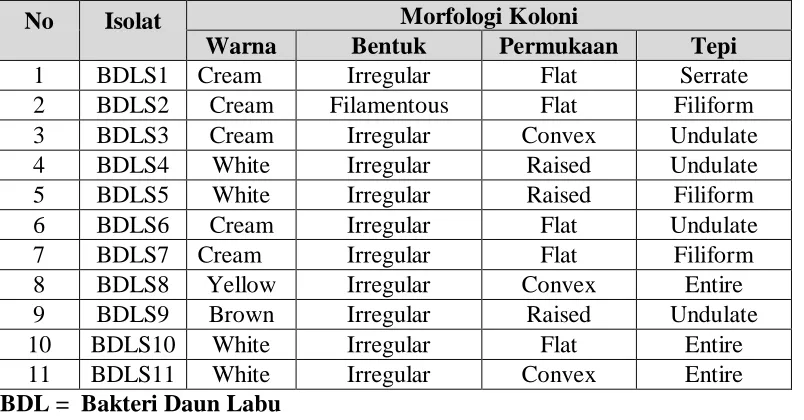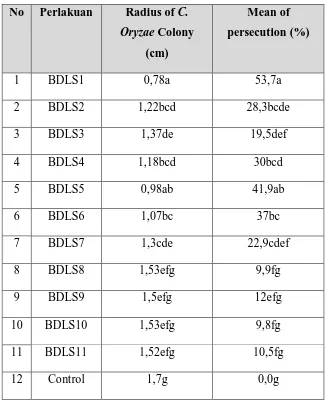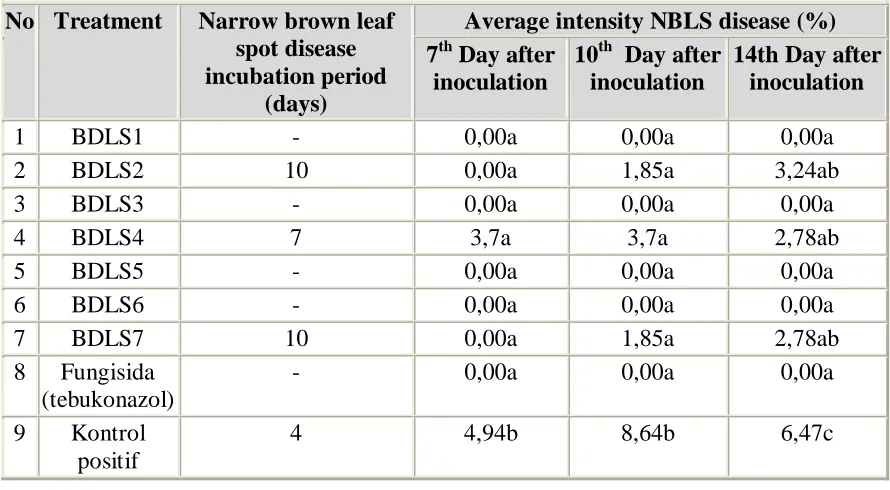Int er nat ional Seminar Biot echnology 1
ANTAGONISTIC POTENCY OF BACTERIA ISOLATED FROM LOCAL MICROORGANISM OF MAJA IN AGAINTS ON DAMPING OFF DISEASE
(Rhizoctonia solani Kuhn.) AND GROWTH OF PADDY
HERSANTI
Department of Plant Protection, Faculty of Agriculture Universitas Padjadjaran
Hersanti : [email protected]
ABSTRACT
Damping off disease, caused by Rhizoctonia solani Kuhn, is one important diseases on field paddy. The use of antagonistic bacteria as bio-control agents is an alternative control method toward damping off disease which is friendly to environment.
The purpose of research was to examine the abilities of antagonistic bacterial isolate from maja fruit to suppress R. solani. The experiments were carried out in the Phytopathology Laboratory and Glasshouse of the Department of Plant Pests and Diseases, Faculty of Agriculture, Universitas Padjadjaran from Juny 2010 to September 2010.
There were two experiments i.e.: test of antagonistic ability of the isolates in dual culture method and test of ability of the bacterial isolate to increase growth of paddy var IR64 in the glasshouse. Those experiments were arranged in the completely randomized design consisted of 9 treatments and 3 replications for in vitro and growth test of paddy.
Eight of bacterial isolates from maja fruit showed antagonistic ability against R. solani in vitro. The highest suppression was shown by BM4, BM5 and BM6 isolate, with percentage inhibition 81,6% , 88,6% and 86,9%. All bacterial isolates have ability to increase the growth of paddy.
Keyword : Rhizoctonia solani, MOL of maja fruit, paddy, Antagonistic bacteria
INTRODUCTION
Narrow brown leaf spot disease caused by Cercospora oryzae Miyake is a major
disease on paddy (Agrios, 2004; Koga, 2001). This diseases is important disease on rice
in Indonesia (Semangun, 2004). According Soenarjo et al. (1991) that diseases intensity
of Narrow brown leaf spot disease in field reach 40%, and spora of C. oryzae can
survive in straw, and disappear by wind.
Organic plantation system with SRI (System of Rice Intensification) using a
mixture of natural materials found in the area around rice plantation as the effort to
Int er nat ional Seminar Biot echnology 2 water, water, rice, maja fruit, bamboo sprout, papaya, bananas, water, sugar cane,
squash leaf shoots, golden slug, and vegetables. Material’s composition is adjusted to
the available source material, and then fermented. Results of fermentation are known as
the Local Microorganisms or MOL (Ekamaida, 2008; Hersanti & Djaya, 2008). MOL
has been used by rice farmers, especially rice farmers using SRI planting methods
(Hersanti & Djaya, 2008). According to Uphoff (2004) organic paddy intensification
system does not require chemical fertilizers and other chemicals, but will use the
materials available in nature.
Hersanti & Djaya research (2008) has been obtained 19 (Nineteen) isolated
bacteria of different types of Mol which are from cebreng leaves’ Mol, shoots squash’s
Mol, maja fruit’s MOL, bamboo sprout’s MOL, bananas’ Mol, banana tuber’s MOL.
Test results of the dual culture of 19 (nineteen) isolated bacteria note 6 isolated bacteria
have the antagonistic ability against fungus Rhizoctonia oryzae and 4 of isolated
bacteria have the antagonistic ability against fungus Cercospora oryzae.
Antagonist ability of the bacteria that come from to diseases is not yet known.
Therefore, the research of utilizing antagonist isolated bacteria from chayote leaf MOL
needs to be done, so it can be used as biocontrol agent in controlling the Narrow brown
leaf spot disease on paddy.
RESEARCH METHOD
Research conducted in the Laboratory of Phytopathology and Greenhouse of
Department Plant Protection, Faculty of Agriculture, Universitas Padjadjaran. Method
used in this research is two stages of research scale which are in vitro test and In-vivo
(greenhouse) test.
Testing the in-vitro
Testing potential antagonistic isolate bacteria of chayote leaf MOL to prevent
the growth of fungi C. oryzae is done using the method of dual culture test with the
Complete Random Design . Isolated bacteria obtained on the chayote leaf MOL are 11,
Int er nat ional Seminar Biot echnology 3
Testing the in-vivo
Tests for antagonist isolated bacteria ability to suppress Narrow brown leaf spot
disease on paddy are done using experiment method with the Complete Random Design
(RAL). Treatment is based on the number of candidates tested antagonist bacteria,
which is as much as 7 isolated antagonist bacteria obtained after the in vitro test-scale,
and added a treatment of active tebukonazol fungicide, positive control (C. oryzae
inoculation fungi). Each treatment was repeated three times. Observation data analyzed
statistically using the program SPSS version (16.0). Differences between treatments
tested using the Duncan Double Distance Test in the 5% significant milestone.
RESULTS AND DISCUSSION
In-vitro test
In the chayote leaf Mol the in Nutrient Agar (NA) medium was found as much
as 11 isolated bacteria. Isolated bacteria found are differentiated according to the color
of the colony morphology, shape, surface, and the colony edge (Leung & Liu, 2002;
Johnston, 2007). Characteristic colony morphology of 11 isolated bacteria can be seen
in Table 1.
Table 1. Isolated bacterial colonies Morphology of chayote leaf Mol on the Nutrient Agar (NA) medium
No Isolat Morfologi Koloni
Warna Bentuk Permukaan Tepi
1 BDLS1 Cream Irregular Flat Serrate
2 BDLS2 Cream Filamentous Flat Filiform
3 BDLS3 Cream Irregular Convex Undulate
4 BDLS4 White Irregular Raised Undulate
5 BDLS5 White Irregular Raised Filiform
6 BDLS6 Cream Irregular Flat Undulate
7 BDLS7 Cream Irregular Flat Filiform
8 BDLS8 Yellow Irregular Convex Entire
9 BDLS9 Brown Irregular Raised Undulate
10 BDLS10 White Irregular Flat Entire
11 BDLS11 White Irregular Convex Entire
Int er nat ional Seminar Biot echnology 4
(a) (b) (c)
(d) (e) (f)
(g) (h) (i)
(j) (k)
Int er nat ional Seminar Biot echnology 5 Table 2. Persecution Percentage of 11 1isolate bacteria of Chayote leaf against C.
oryzae dual culture test on 8th day.
No Perlakuan Radius of C.
Oryzae Colony
(cm)
Mean of
persecution (%)
1 BDLS1 0,78a 53,7a
2 BDLS2 1,22bcd 28,3bcde
3 BDLS3 1,37de 19,5def
4 BDLS4 1,18bcd 30bcd
5 BDLS5 0,98ab 41,9ab
6 BDLS6 1,07bc 37bc
7 BDLS7 1,3cde 22,9cdef
8 BDLS8 1,53efg 9,9fg
9 BDLS9 1,5efg 12efg
10 BDLS10 1,53efg 9,8fg
11 BDLS11 1,52efg 10,5fg
12 Control 1,7g 0,0g
Int er nat ional Seminar Biot echnology 6
(a) (b) (c)
(d) (e) (f)
(g) (h)
Int er nat ional Seminar Biot echnology 7 Picture 2. Percusation of bacteri isolate chayote leaf againts C. oryzae on 8th days, show of Isolate BDLS1 (a), BDLS2 (b), BDLS3 (c), BDLS4 (d), BDLS5 (e), BDLS6 (f), BDLS7 (g), dan Control (h).
Observation results for activity deceleration are indicated by clear zone between
the colony fungus C. oyzaer and the isolate bacterial in the medium. Antagonist bacteria
produce the antibiotics, siderofor, and other secondary metabolite that does damage to
the growth of microorganisms or prevent other activities (Fravel Hasanuddin in 1988,
2003). As presented by Howell and Stipanovic (1979) to Hasanuddin (2003), that the
antibiotics bacteria Pseudomonas fluorescens effectively pressing the growth of
Rhizoctonia solani, the pathogenic cause of topple shoot disease in the cotton sprout
plants and also pyoluteorin antibiotics that can suppress Pythium ultimum growth.
Some bacteria have been widely used as bio control agents through the emphasis
of antibiotics production to suppress the development of pathogen or disease (Mukerji
& Garg, 1988 in Yulia et al. 2008). Microbes that produce antibiotics considered most
appropriate to use as bio control agents compared with the other antagonism ways such
as competition and parasitism (Yulia et al. 2008).
Other mechanism of the bio control agents is the consumption competition of
food source or certain elements burly, so that constrain the growth room of other
microorganisms (Weller Hasanuddin in 1988, 2003; Brock, 1966 in Sudadi, 2005).
In-vivo test
On the observation results of known incubation period of infectious Narrow
brown leaf spot disease of paddy plants has the different appearance on each bacteria
treatment test. The Result of research Suganda et al. (2002) symptom narrow brown
leaf spot diseases occur on 4th – 7th after inoculation. And according Suparyono et al.
(2003) symptom of Narrow brown leaf spot disease occur on 5th – 6th after inoculation
Int er nat ional Seminar Biot echnology 8 Picture 3. Symptom of NBLS on leaf paddy 10th after inoculation.
Table 3. Narrow brown leaf spot disease intensity on paddy plants
No Treatment Narrow brown leaf spot disease incubation period
(days)
Average intensity NBLS disease (%) 7th Day after
inoculation
10th Day after inoculation
14th Day after inoculation
1 BDLS1 - 0,00a 0,00a 0,00a
2 BDLS2 10 0,00a 1,85a 3,24ab
3 BDLS3 - 0,00a 0,00a 0,00a
4 BDLS4 7 3,7a 3,7a 2,78ab
5 BDLS5 - 0,00a 0,00a 0,00a
6 BDLS6 - 0,00a 0,00a 0,00a
7 BDLS7 10 0,00a 1,85a 2,78ab
8 Fungisida
(tebukonazol)
- 0,00a 0,00a 0,00a
9 Kontrol
positif
4 4,94b 8,64b 6,47c
Description: The average value which followed by the same letter in the same column
do not differ significantly according to Duncan Double Distance Test in 5% significant milestone
Table 6 show that high NBLS disease intensity on occurs on positive control at
10th after inoculation or paddy plant be grown up 27 days. This result appropriate with
research of Suganda (2002) that symptom of NBLS occur at paddy be grown up 3
Int er nat ional Seminar Biot echnology 9
CONCLUSION
Among the eleven bacterial isolates tested by dual culture, 7 isolates showed
antagonistic ability against Cercospora oryzae invitro. The highest suppression was
53,7% shown by BDLS1 isolate. Four bacterial isolates i.e.: BDLS1, BDLS3, BDLS5,
and BDLS6 were effective in suppressing narrow brown leaf spot (C. oryzae) on paddy
var IR64 in the glasshouse.
LITERATUR
Agrios, GN. 2004. Plant Pathology. 4th Ed. Academic Press. London.
Ekamaida. 2008. Pengelolaan lahan pertanian ramah lingkungan dengan sistem intensifikasi tanaman padi melalui pemanfaatan mikroorganisme lokal dalam pembuatan kompos (Studi kasus di Desa Sidodadi Kabupaten Deli Serdang). Available online at http://library.usu.ac.id (Diakses tanggal 8 September 2008).
Hasanuddin. 2003. Peningkatan peranan mikroorganisme dalam sistem pengendalian penyakit tumbuhan secara terpadu. Jurusan Hama dan Penyakit Tumbuhan
Fakultas Pertanian Universitas Sumatera Utara. Available online at
http://library.usu.ac.id (diakses tanggal 8 September 2008).
Hersanti dan L. Djaya. 2008. Antagonism of Bacterial Isolates from Local Microorganisms against Rhizoctonia solani and Their Effect on the Growth of Rice Seedlings. Mini Symposium Biocontrol in conjuction with ICMNS. Sekolah Tinggi Ilmu Hayati Institut Teknologi Bandung.
Koga, H. 2001. Cytological aspects of infection by the rice blast fungus pyricularia oryzae. In: sreenivasaprasad, s, and r. Johnson (eds.). Major fungal disease of
rice recent advances. Kluwer cademic A Publishes. pp. 87.
http://books.google.co.id/books. Diakses tanggal 24 September 2008.
Johnston, D. 2007. Colony Characteristics. http://faculty.clinton.edu/faculty/ donald.johnston/. Diakses tanggal 22 November 2008
Soenarjo, Edi, Djoko, S. Damarjati, dan Mahyuddin Syam. 1991. Buku 3 Padi. Penelitian dan Pengembangan Pertanian. Pusat Penelitian dan Pengembangan Tanaman Pangan Bogor. 167 hlm.
Int er nat ional Seminar Biot echnology 10 Suganda, T., E. Rismawati, E. Yulia, dan C. Nasahi, 2002. Pengujian kemampuan
beberapa bahan kimia dan air perasan daun tumbuhan dalam mengiduksi resistensi tanaman padi terhadap penyakit bercak daun Cercospora. Jurnal Bionatura 4(1) : 17-28.
Suparyono., JLA Catindig, NP Castila, and FA Elazequi. 2003. Narrow Brown Leaf
Spot Available online at: http://www.knowledgebank.irri.org/
RiceDoctor/Fact_Sheets/Diseases/Narrow_Leaf_Brown_Spot.htm. (Diakses
tanggal 4 Juni 2009).
Uphoff, N. 2004. System of rice intensification responds to 21st century needs. Grain of truth. 42 p.
Yulia, E., dan F. Widiantini. 2007. Potensi Bakteri Filoplen Asal Tanaman Padi dalam
Menekan Perkembangan Penyakit Busuk Batang Helminthosporium (
sigmoideum Cav.) pada tanaman Padi. Jurnal Agrikultura. 18 (3) : 190-196.
Yulia, E., F. Widiantini, R. Firmansyah, dan A. Karuniawan. 2008. Kemampuan Ekstrak dan Bakteri Inhabitan Mucuna pruriens Linn. dalam Menekan Penyakit Bercak Daun Cercospora dan Meningkatkan Pertumbuhan Tanaman Kacang Tanah. Jurnal Agrikultura. 19 (1) : 50-59.


